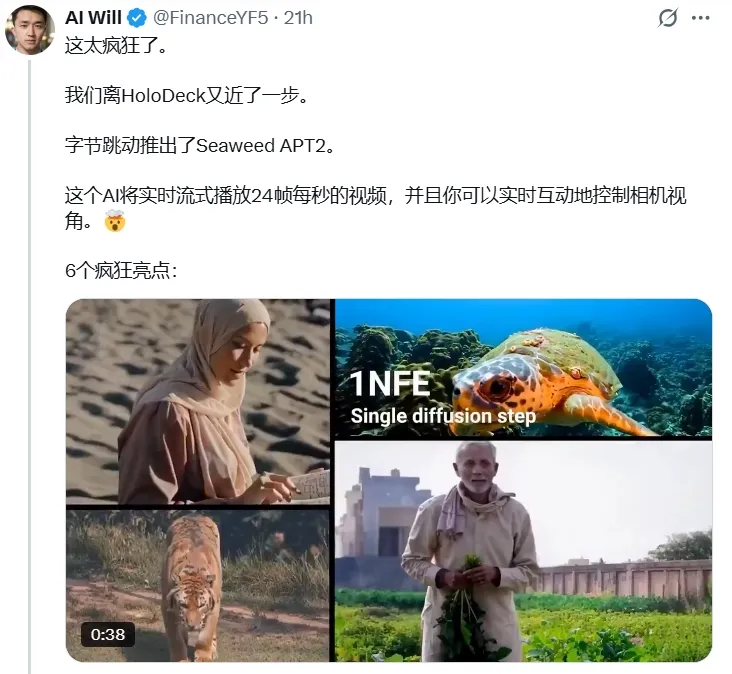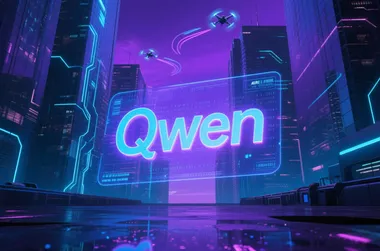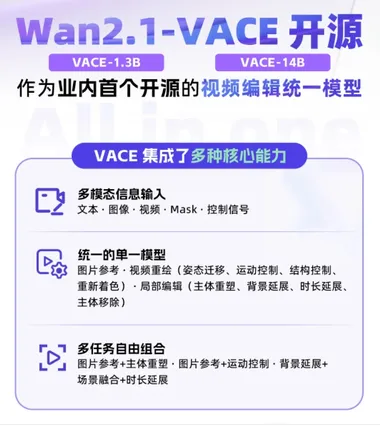Recently, ByteDance launched Seaweed APT2, a revolutionary AI video generation model. Its breakthroughs in real-time video stream generation, interactive camera control, and virtual human generation have sparked heated discussions in the industry. This model is praised as "an important step towards the Holodeck" due to its efficient performance and innovative interactive features.
Seaweed APT2: A New Benchmark for Real-Time Video Generation
Seaweed APT2 is an 800-million-parameter generative AI model developed by ByteDance's Seed team, specifically designed for real-time interactive video generation. Compared to traditional video generation models, Seaweed APT2 adopts the Auto-Regressive Adversarial Post-Training (AAPT) technology, generating a latent space frame containing four frames of video through a single network forward evaluation (1NFE), significantly reducing computational complexity.

The model can generate real-time video streams at 24 frames per second with a resolution of 736x416 on a single NVIDIA H100 GPU, and supports high-definition output at 1280x720 resolution with eight H100 GPUs. This efficient performance demonstrates its great potential in interactive application scenarios.
Core Functions: Creating Immersive Interactive Experiences
The innovation of Seaweed APT2 lies in its powerful real-time interactive capabilities, with six highlights:
Real-Time 3D World Exploration: Users can freely explore the generated 3D virtual world by controlling the camera view (e.g., panning, tilting, zooming, moving forward or backward), providing an immersive experience.
Interactive Virtual Human Generation: Supports real-time generation and control of virtual character poses and movements, suitable for scenarios like virtual anchors and game characters.
High Frame Rate Video Streams: Achieves smooth video generation at 24 frames per second and 640x480 resolution on a single H100 GPU, with higher-quality 720p output supported on eight GPUs.
Input Recycling Mechanism: By recycling each frame as input, Seaweed APT2 ensures consistent actions in long videos, avoiding common action breaks in traditional models.
Efficient Computation: Generates four frames of content through a single forward evaluation, combined with Key-Value Cache (KV Cache) technology, supporting long video generation with significantly higher computational efficiency than existing models.
Infinite Scene Simulation: By introducing noise into the latent space, the model dynamically generates diverse real-time scenes, showcasing "limitless possibilities".
Technical Breakthroughs: The Revolution of Auto-Regressive Adversarial Training
Seaweed APT2 abandons the traditional diffusion model's multi-step inference mode and adopts the Auto-Regressive Adversarial Post-Training (AAPT) technology, converting the pre-trained bidirectional diffusion model into a unidirectional auto-regressive generator. This method optimizes video realism and long-term temporal consistency through adversarial objectives, solving common issues like motion drift and object deformation in traditional models during long video generation.
In addition, the model performs exceptionally well in **Image-to-Video (I2V)** scenarios, where users only need to provide the initial frame to generate coherent video content. This makes it particularly suitable for interactive applications such as virtual reality (VR), game development, and real-time content creation.
Applications: From Virtual Anchors to Immersive Narratives
Seaweed APT2's real-time and interactive nature opens up broad application prospects:
Virtual Anchors and Character Animation: Through real-time pose control and motion generation, Seaweed APT2 provides smooth and natural animation effects for virtual anchors or game characters, reducing the cost of traditional Live2D or 3D modeling.
Interactive Film and Education: Supports multi-camera narratives and dynamic scene generation, suitable for interactive short films and immersive educational content.
Virtual Reality and Gaming: Through 3D camera control and scene consistency optimization, Seaweed APT2 provides real-time generated dynamic worlds for VR and game development, approaching the experience of "Star Trek Holodeck".
E-commerce and Advertising: Quickly generate product demonstration videos or virtual character ads, enhancing content creation efficiency.
Challenges and Prospects: Towards a New Future of AI Video
Despite significant technical breakthroughs, Seaweed APT2 still faces challenges. For instance, the model has not yet undergone human preference alignment and further fine-tuning, leaving room for improvement in realism and detail representation. Additionally, real-time generation of high-resolution videos requires high hardware requirements, potentially limiting access costs for some users.
AIbase analysis believes that the release of Seaweed APT2 marks a major transformation from static creation to dynamic interaction in the field of AI video generation. ByteDance promises to release more technical details and even open-source code in the future, which will further drive community innovation. With continuous iteration, Seaweed APT2 is expected to become the "infrastructure" for virtual content creation, bringing revolutionary changes to fields such as film and television, gaming, and the metaverse.
Industry Impact: Reshaping the AI Video Ecosystem
Compared to OpenAI's Sora or Google's Veo, Seaweed APT2 achieves comparable or even superior performance with lower parameter scale and computational cost. This "small but mighty" strategy not only lowers the technical threshold but also provides high-performance video generation tools for small and medium-sized teams and individual creators. AIbase observes that attention to Seaweed APT2 is rapidly rising, with its demonstration videos on social media sparking widespread discussion, showcasing excellent generation capabilities from single frames to long-form narratives.
Conclusion
ByteDance's Seaweed APT2 sets a new benchmark in the AI video generation field with its breakthrough functions in real-time interaction, 3D world exploration, and high-frame-rate video generation. From virtual humans to immersive narratives, this model is redefining the possibilities of content creation.



